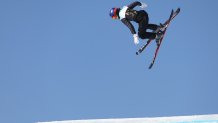When watching the Winter Olympics, most of us can appreciate how spectacular the Olympians are and the risks they're taking on — whether they're going 90 mph down an icy track in a luge or launching off a halfpipe and soaring through the air with skis attached to their feet (an event that resulted in 28% of participants getting injured at the 2018 Games). But unless you're an extreme athlete yourself, it's hard to understand how much skill is necessary in order to, simply put, not die while competing in these events.
The degree of danger varies from Winter Olympic sport to sport, and deaths during the Olympics are rare. The last one occurred in 2010, when Georgian luger Nodar Kumaritashvili lost control of his sled while training and crashed into a steel pole.
Still, these events seem death-defying to the untrained eye, and in many cases they are. That's why NBCLX is asking experts to break down some of the most mind-boggling moves at the 2020 Games in a series called "How Did They Not Die?"
Figure skater Kamila Valieva of Russia's historic quad jump at the Winter Olympics
Over the weekend, 15-year-old Russian Kamila Valieva landed a quadruple salchow, making her the first woman to land any quadruple jump in Olympic history. She went on to clinch gold in the figure skating team event.
A salchow is defined as "a figure-skating jump with a takeoff from the back inside edge of one skate followed by one or more full turns in the air and a landing on the back outside edge of the opposite skate," according to Merriam-Webster.

It sounds complicated (four full turns — what?!) but Valieva's success can actually be explained with basic physics, said Josh Baxter, Ph.D., director of University of Pennsylvania's Human Motion Lab. To perform her jump, she needed to apply rotational force, aka torque, against the ground, and as her body started to twist, to bring her arms into the midline of her body to spin faster.
"It seems that she was able to apply such a large torque to the ground and bring her arms in so close to the midline of her body that she's able to twist around more than anyone else has done before," Baxter explained.
The most common error with a salchow is under- or over-rotation, said Dr. Joan Rubinger, founder of All Pro Sports Medicine. And consider that bones can easily break when you land with a lot of torque and speed. Plus the risk of landing wrong is greater when relying on a blade only .04 to .06 inches wide.
Figure skating boots provide a lot of stability for the ankle, but Valieva's were still doing a lot of work. To understand just how much, Rubinger suggested standing while barefoot. Then, lift one leg off the ground slowly, and feel the muscles in your toes and foot move around as you try to balance. In a skate, these muscles can't do the same work because only the blade is in contact with the ground, so balancing relies on the lower leg and ankle.
As Dr. Samir Mehta, an orthopedic surgeon at Penn Medicine, explained it: "If you land on your leg and spin or rotate in an awkward way, it's actually quite easy to break your tibia or your femur. ... Let's say they [misland] and then the entire skate goes sideways. All that force that goes into their ankle, and now they dislocated or broke their ankle."
Freeski big air and snowboarding slopestyle at the Winter Olympics
The finals in snowboard slopestyle concluded earlier this week with Canada's Max Parrot and New Zealand's Zoi Sadowski-Synnott taking home gold in the men's and women's events respectively. (Team USA's Julia Marino earned silver, the U.S.'s first medal of the 2022 Games.) In women's freeski big air, Chinese-American Eileen Gu took home gold competing for the Olympics host country, and the men's final will take place Wednesday.

We're lumping these events together because they look similarly crazy with athletes wearing large apparatuses on their feet, sliding down a snow covered ramp and spinning dozens of feet above the ground. In big air, athletes can clear 50 feet.
Baxter said that with these events, there's "no margin for error," in part because they're twisting while flipping.
"Once they leave the jump, it's predetermined where they're going to land, so they're flying through space and having to rotate their bodies and get their snowboard down to land at just the right moment. It's pretty remarkable that [they're] able to land these jumps so frequently," he said.
The moves that these athletes perform require "the ability to feel where you are in midair, to know where the ground is, how far it is away, how fast you are rotating and spinning, how much space you’ve got left to complete your rotations, and whether you need to pull in tighter to increase your rate of rotation, or open out early, in efforts to slow your rotation," Rubinger said.

Asked to explain the risk of these events, Mehta turned to the medical concept of LD50, or the dose of a medication where 50% of people who receive it would die. Apply this idea to height, and 50% of people who fall four stories, between 40 and 60 feet, will die.
Falling on snow and protective equipment helps, so the LD50 for big air and slopestyle is probably a bit higher than 40 feet, Mehta said, but the heights these athletes reach are still "pretty treacherous." Falling from a height often leads to broken pelvises, femurs, tibias and ankles, but a serious head or spinal cord injury and even paralysis are also possible.
Whether it's spinning on skates, skis or a snowboard, success is all about physics, vectors, torque, velocity, gravity — the list goes on. But whether athletes understand these concepts is "irrelevant," Mehta said, because either way "they're able to master it."

